|
Leave it to the Italians to come up with some impressive camera designs! Here follows a small collection.
Officine Galileo Condor I
Named after the inventor of one of the earliest microscopes, I am not sure how much Officine Galileo had to do with its namesake, but the company did produce some interesting cameras and made its own shutters and lenses. The Condor I was introduced ca. 1948 and was a collapsible lens 35mm camera which featured helical focussing and a coupled rangefinder with separate viewfinder. It had an Officine Galileo Eliog 50mm f/3.5 or f/2.8 lens in an Aplon Rapid shutter. The camera was also sold under the name Ferrania, a better known camera company (see Ferrania Lince further below).
The company Galileo, later Officine Galileo, was founded in Florence in 1864 and made scientific and astronomical instruments as well as fine mechanics. It was involved in consumer camera production only for a short while, but still survives today as Selex ES.

A 1948 Officine Gallileo Condor I with in-house Aplon-Rapid shutter and Eliog f/2.8 lens.
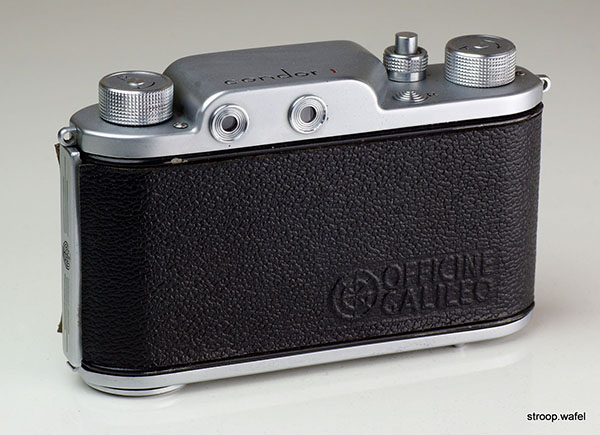
Rear view Officine Gallileo Condor I showing the separate viewfinder and rangefinder windows.

Top view of Officine Gallileo Condor I showing the collapsible lens in extended position.
Officine Galileo / Ferrania Condoretta
The Condoretta was essentially a dressed-down version of the Condor above. It lacked the rangefinder, had a less well specified lens (Eliog f/3.5 or Terog f/4) with front-cell focussing and an Aplon shutter with a smaller speed range. On the positive side, it did have an accessory shoe. The lens mount looks collapsible, like on the Condor, but it isn't. The lens is actually closer to the film plane than on the Condor. The focal length of the lens was also shorter: 40 mm instead of 50 mm on the Condor.
Like the Condor, also this model can be found with various brandings, such as Galileo Ferrania, or in fact none at all other than the shutter and lens names. I reckon the lens and shutter were built by Galileo, and the bodies and assembly were done by Ferrania.
The Condoretta is not to be confused with the Condor Junior, which was a Condor without rangefinder as well, but did have the better shutter and helical focus mount of that model.
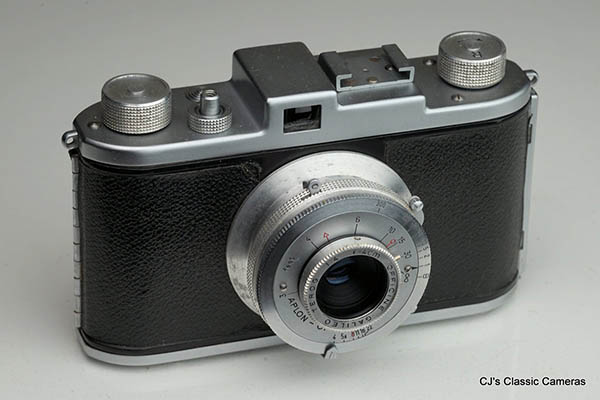
An Officine Gallileo Condoretta with Terog 40mm f/4 lens in Aplon shutter.
Klein IIa
This is a rather rare camera which was produced in only small numbers in Rome in the early 1950s. Little is known about the company, other than that it produced three slightly different versions of this camera. They were simple viewfinder cameras with collapsible lenses and shutters of low specification. The first model used a cassette system and can be recognised by its lack of a rewind knob. The next model, marked KII, did have a rewind knob as it used regular 35mm film cartridges. It had more shutter speeds and an adjustable aperture compared to the Klein I. The Klein IIa was not marked as such and was essentially a Klein I with the accessory shoe replaced by a rewind knob. However, on my example the rewind knob does not properly engage with standard 135 film cartridges, so the knob appears to be purely cosmetic. The camera was bottom loading; to load film one had to pull out the pressure plate before film could be inserted. The camera had only one film sprocket, which was located near the bottom, so the film did not need to be cut with a longer leader like on bottom-loading Leicas and Ilocas.

The Klein IIa, as we say in Dutch: 'klein maar fijn' (small but sweet).
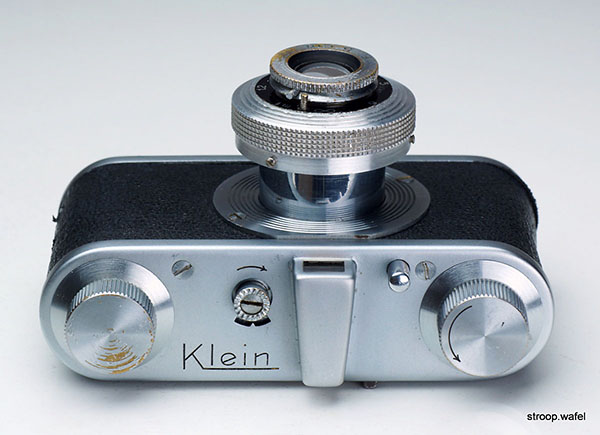
Top view of the Klein IIa. The lens was collapsible.
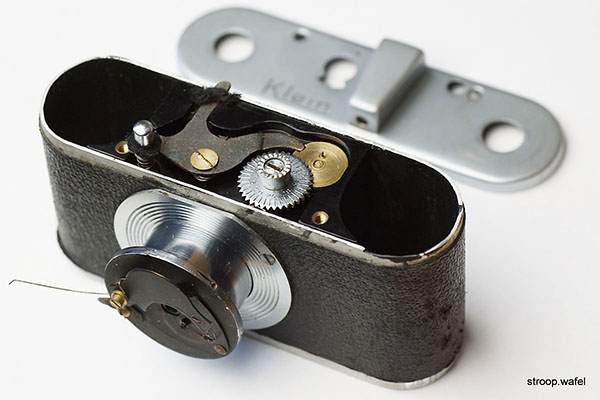
The inside of the camera displayed a similar simplicity as the outside. Note the simple single blade shutter.
Gamma Perla
Gamma was a little known Italian camera maker based in Rome founded shortly after WWII and probably best known for its rather magnificent self-named Leica copy. In 1951 Gamma introduced their next camera: the Perla. It was a quality Leica-styled rangefinder camera with large 1:1 viewfinder, fixed collapsible lens and leaf shutter. Somewhat unusual for an Italian camera maker, which often used Italian-made lenses and/or shutters, the Perla most commonly came with familiar lens-shutter combinations such as Schneider-Kreuznach lenses and Compur or Prontor shutters. A viewfinder-only variant of the Perla was named the Stella. The Perla itself was upgraded in 1954 to the Perla II, which was somewhat larger and heavier than its predecessor and equipped with wind lever. A variant of the original Perla without collapsible lens was also introduced, the Perla I. Gamma went on to produce several other more simple cameras, like the Alba, Atlas and Atom, but stopped producing cameras in 1958. About 13,000 pieces of the various Perla models were produced.
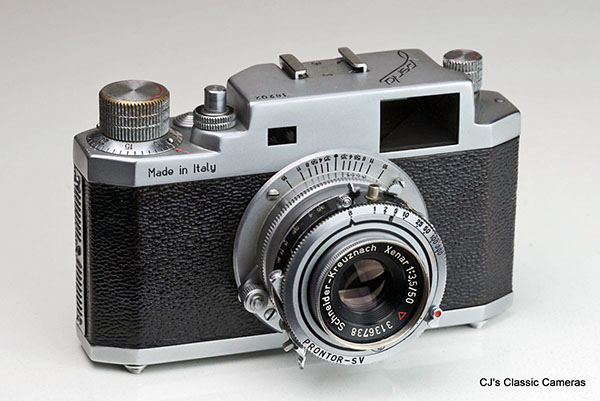
A Gamma Perla with Schneider-Kreuznach Xenar 50mm f/3.5 lens in Prontor-SV shutter. The top model would have had a Xenon lens in Synchro-Compur shutter.
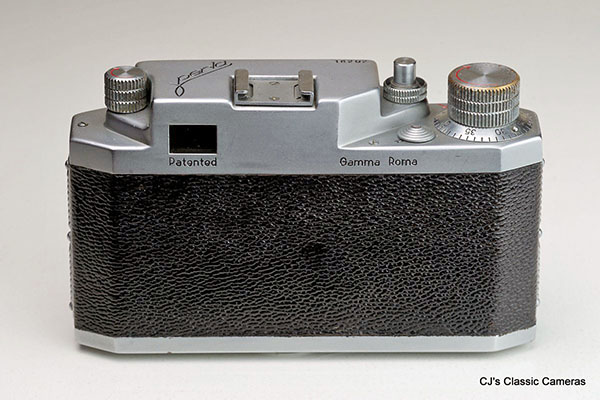
Rear view of the Gamma Perla, showing the company name and its location.

Top view of the Gamma Perla showing the collapsible lens mount, which only moved by about 6 mm and makes you wonder what the point of it was. Not worth the risk forgetting to pull it out and wasting a shot I think. Also note the swirling line underneath the Perla name in the shape of the Greek letter gamma.
Closter Princess
Closter was another relatively unknown Italian camera maker (based in Rome) which nevertheless made some very decent cameras in the early 1950s. The Princess turned out to be an interesting one. Like the Voigtlander Prominent it had a large dial on top of the camera to adjust the focus, which would move the whole lens base forward and backward. However, the position of the dial was rather inconveniently right in the centre of the top housing, which meant you could very easily block the rangefinder window whilst trying to focus.

A Closter Princess with Closter Aries Anastigmat 50mm f/4.5 lens in unmarked shutter both presumably made by Closter themselves. Note that the rewind knob is not original.
Another interesting design feature was the slow speed mechanism for the shutter, which was an external unit located in the camera body and was activated via a couple of levers. A separate slow speed mechanism is not uncommon in focal plane shutters, e.g., the Leica III range, but I have never seen this on a leaf shutter. Despite the complexity, it works fine.
The Princess was succeeded by the Princess II, IIa and Record, although changes were only small, whilst the Princess Junior was a viewfinder only version. The final model was the Closter Sport, a much simpler camera mainly made of plastic, probably in an attempt to join the move towards cheaper mass-produced cameras in the late 1950s.

Top view of the Closter Princess showing the focus knob in the centre of the top plate. Note that all controls are in Italian, clearly this camera was made for its domestic market.

| |
Inside view of the Closter Princess showing amongst others the slow speed mechanism next to the lens tube.
|
Bencini Koroll 24S
Bencini from Milan made a range of basic rollfilm and 35mm cameras. Their cameras were more about form than function and the Koroll 24S certainly looked the part. It had a fixed shutter speed of 1/50s, but a B setting could also be set by using a lever. It had two apertures, f/9 and f/16. The shutter has only one blade, the f/16 aperture was a rectangular mask!
It had a front-cell focussing lens of unknown make and produced 24 photos on 120 rollfilm in 4x6 portrait format. It had two spy windows as 120 rollfilm had no markings for 24 frames, thus the film needed to be wound till one would see the frame number in the left window, then in the right window for the next frame. This was more commonly seen on 127 roll film cameras with 3x4 frames, like the Wirgin Gewirette and the Ising Pucky.
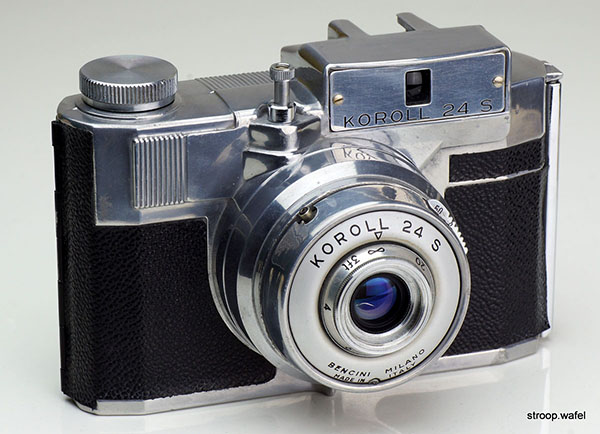
The undeniably stylish Bencini Koroll 24S.

Rear view of Bencini Koroll 24S showing the two spy windows needed to get 24 frames on a 120 roll film.
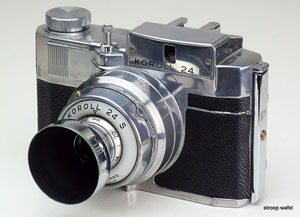

Bencini Koroll 24S with original lens hood (left) and screw-in lens cap (right).
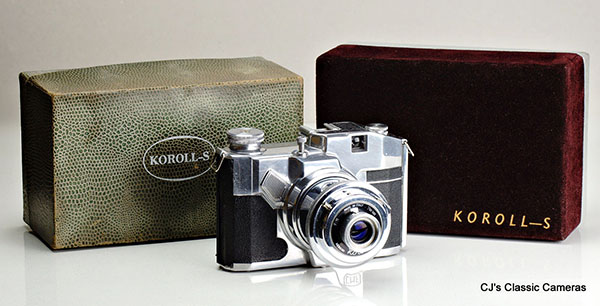
Here's a different member of the Koroll clan, the Koroll-S. This was a 6x6 format camera with a telescopic front-cell focussing lens. It had a second spy window at the back for 4x6 exposures, so presumably a mask must have been available, as none is built in. As can be seen in the photo the metal on these cameras polishes up beautifully.
Also shown are two different boxes for this model. The red velvet one had a tag from Boots (a British drug store) inside it, and is the box most commonly found, at least here in the UK. The snake skin box I had not seen before this camera came up for sale, perhaps it was imported from the continent at some stage?
Bencini Comet 44
The Comet 44 was a 127 rollfilm camera with a very similar styling to its bigger brother, the Bencini Koroll above. It had a 4x4 cm square film format (hence the name) and featured a better viewfinder than the (older) Koroll. It had two shutter speeds and two apertures. The lens was marked Acromatico 55mm 1:8. The camera had a single spy window at the back for a total of 12 exposures. In addition to the black leatherette version it was also available in beige trim.
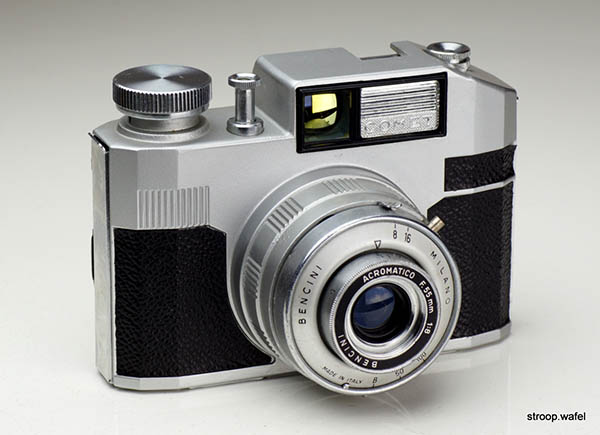
A Bencini Comet 44. The button on the top right side of the camera needed to be pulled up to insert the film spool while loading the camera.

Rear view of the Bencini Comet 44 with a single spy window.
Bencini Comet III
When I first got this camera, as part of a larger lot of cameras, I dismissed it as a movie camera, in which I have little interest. It was only later upon closer inspection that I realised that it was in fact a box camera for 127 roll film, and that I had been fooled by its curious design. This design turns out to be the camera's charm and it certainly sets it apart from any other box camera I have seen. Well done Bencini!
It specifications weren't too much to write home about, it had fixed shutter speed and aperture, a coated meniscus lens (presumably a doublet), but somewhat surprisingly, the lens had a variable focus with a range of 1m/3ft to infinity. The camera had two red spy windows at the back, as it had a 3x4 film frame.

A Bencini Comet III. The large knob on the right is the wind knob, the one on the left is the shutter release. A small wheel beneath the latter releases the camera back. Unlike most other half frame rollfilm cameras, keeping the camera straight up would result in a landscape picture.
Bencini Cometa
The Bencini Cometa a 127 rollfilm camera like the Comet44 above, but in a smaller more compact body. It still had a 4x4 cm square film format as well as two shutter speeds and two apertures. The lens is unmarked but it appears to be a meniscus lens with a largest aperture of f/8. The film frame was slightly curved to offset lens aberrations. The viewfinder consisted of two pieces of plain glass, the front one had a gold coat to improve contrast.
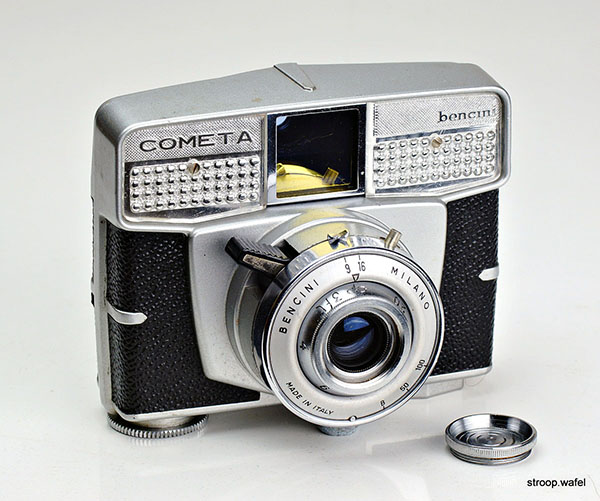
A Bencini Cometa. Perhaps not the most attractive camera but sort of cute in its uggliness.
Ferrania Lince III
Ferrania produced a wide range of cameras, including the Lince range, which were 35mm cameras. The Lince 3 had a brightframe viewfinder and had fully manual aperture and speed control. It featured a simple Vero shutter and Steinheil Cassar 45mm f/2.8 lens with front-cell focussing. It had a conveniently oversized rewind button. An interesting detail was the accessory shoe cover, which needed to be pushed down to mount accessories.
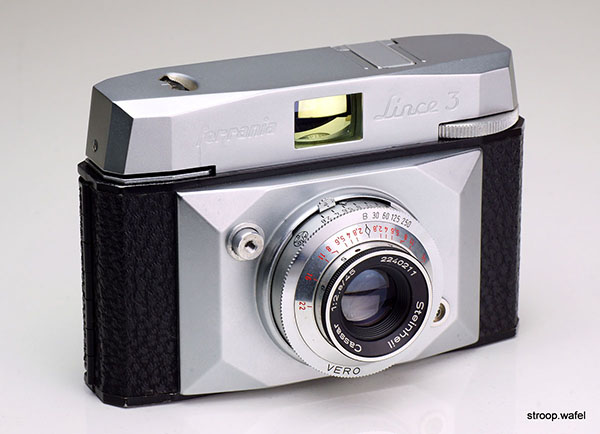
A Ferrania Lince III, again an Italian camera of rather striking design.
Durst Duca
Durst, a company better known for it photographic enlargers, started making photo cameras in 1936. It's first camera was a box camera. This was followed shortly after WWII by the Duca. The Duca was a very small and compact camera that used Karat cassettes and looked more like a small movie camera than a still camera. A large lever on its side was used to advance the film and prime the shutter, and had an integrated frame counter. The Duca had a simple 50mm meniscus lens with fixed f/11 aperture and which could be focussed by turning it, and it had a fixed shutter speed of 1/30.
The Durst Duca, a sympathetic little film camera using Karat cassettes. The photo on the right shows the camera with the side plate removed. Note the two Karat cassettes and the curved film plane to compensate for the simple lens. To load film, the side of the camera had to be removed and the two Karat cassettes could be inserted together with the removable film pressure plate.

A Durst Duca side by side with the Bencini Comet III, another Italian-made film camera that looked like a movie camera. Although the Comet is certainly not a big camera, it dwarfs the very compact Duca.
Durst Automatica
The Durst Automatica was introduced in the late 1950s. It was a viewfinder camera with aperture priority automatic exposure mode and a Schneider Radionar lens. It most remarkable feature was probably its pneumatic shutter, which had a unique soft feel and made a little puff when pushing it. The Durst company obtained several patents for this (see here and here, and was licensed by Agfa for their magnificent Automatic 66, one of the first folding cameras with automatic exposure. The camera oozed quality and Durst paid a lot of attention to detail, for example the wind lever which was recessed into the body but would move up when winding the film. The camera would also operate in fully manual mode.
Durst stopped producing the Automatica in 1963 and started focussing on photographic enlargers instead. On the internet some images of a different model, the EW Automatica, can be found. This model had an interchangeable lens mount similar to that of the Photavit 36 (a Prontor-SLK mount) as well as a rangefinder. I assume this was just a prototype that never came into production, which is a real shame as that would have been a lovely camera to have!
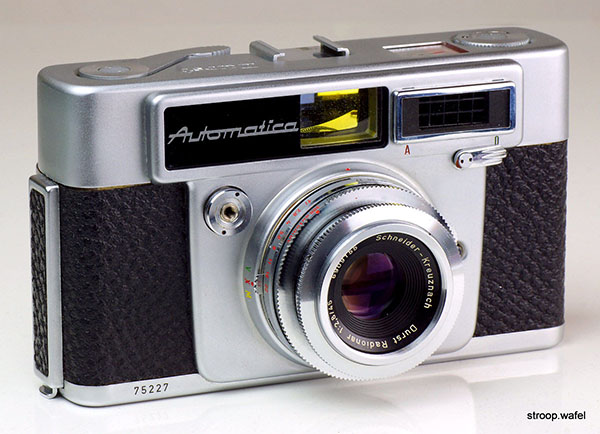
The Durst Automatica with pneumatic shutter.
Durst 66
The Durst 66 was a 6x6 medium format camera introduced in 1956. It was a very robust and somewhat unusual looking camera. As opposed to most other non-folding medium format cameras, which has collapsible lenses, the Durst 66 had large unit-focussing lens. This lens was a simple doublet with a focal lenght of 80 mm and, according the marking on the lens, a diameter of 22 mm. As the aperture openinig is considerably smaller than that, the lens speed was more likely in the f/10 range. It also had a smaller aperture setting, set by the black ring at the lens base. The camera had a curved film plane to compensate for the simple lens construction, a feature which I have seen on 127 film cameras, but not often on cameras for 120 film.

A Durst 66 with coated 80mm Color Duplon lens.
The Durst 66 had a leaf shutter with a range of 1s to 1/300 and also featured a crude extinction meter with four divisions. The shutter appears to be a pneumatic one like on the Automatica above, albeit without the automatic exposure control. Thus the shutter had no springs or a speedcam but regulated exposure through releasing pressurised air through small holes, the size of which determined the shutter speed. On my example the shutter is still accurate after all these years, attesting to the reliability of the mechanism.

Rear view of the Durst 66 showing the rotating disc on the camera back which exposes or covers the red spy window as well as opens or locks the camera back.

Finally, a top view of the Durst 66 showing the extinction meter (number 4 just about visible) as well as exposure instructions and associated shutter speeds.
| 
